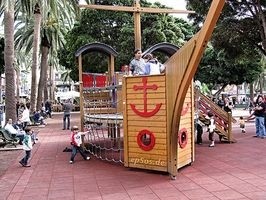Preschool Safety Checklist

Running a preschool takes a significant amount of responsibility. No matter how many people are working at the preschool, there still remains the chance that one of the children could injure themselves. As a result, it is important that preschools maintain a strict checklist for their play areas so that the highest level of safety can be maintained at all times.
Preventing Entrapment or Entanglement
Preschoolers are very inquisitive. While that inquisitiveness is an important part of their learning development, it can also be the cause of injuries. So, there are certain things that must be incorporated into any safety checklist to minimize the chances of inquisitive injuries.
Metal Edges and Protrusions
First of all, all metal edges in all areas must be rounded and smoothed. This way, a child cannot cut him or herself against sharp edges, or catch their clothing on any edges that aren't smooth. Likewise, there should be no small protusions, such as bolts, screws, bars, "s" hooks, or any other equipment sticking out in any play or work areas.
Strings
Children should be dressed for play in clothing that is free from any strings that could be caught anywhere while playing. If strings are present on the clothing, then those strings must be securely tied and/or tucked in.
Openings
There should be no openings that are between three and nine inches long in any play area. This should remove the danger of any child becoming stuck in any structure.
Placement of Play Equipment
A playground is the central area of most preschools. However, careful thought must be given to the placement of various playground equipment. There should be a couple of feet of clear space in between each group of playground equipment. The idea is to remove the danger of children bumping into one another. Additionally, moving equipment, such as swings, should be located at the outer edges of the playground.
Barriers
Preschoolers usually exhibit lots of excitement and energy, especially while they are in a play area. It goes without saying, of course, that they often do not look where they are going. This can result in injury from falls, and the danger increases if a child falls from an elevated step or a ramp.
Play equipment that is elevated more than 20 inches above the ground must feature a protective barrier such as a guardrail enclosing it. A guardrail is preferable to a short wall or solid fence because it allows supervisors clear sight lines to the children in their care.
If tricycle riding is allowed in the playground, then it should be kept separate from main play areas where children may be running around. Additionally, the preschool perimeter must be completely fenced in to make sure that preschoolers do not wander off the property, cannot be approached by unannounced and unwelcome strangers, and are accounted for at all times.
More Tips
When getting ready to finalize the setup of a preschool, be sure to consult various checklists. Check out the "Safety Checklist for Active Play Areas" in the References section, as well as "Toys: Safety Checklist for Preschoolers" in the Additional Resources section of this article.
Preventing Entrapment or Entanglement
Preschoolers are very inquisitive. While that inquisitiveness is an important part of their learning development, it can also be the cause of injuries. So, there are certain things that must be incorporated into any safety checklist to minimize the chances of inquisitive injuries.
Metal Edges and Protrusions
First of all, all metal edges in all areas must be rounded and smoothed. This way, a child cannot cut him or herself against sharp edges, or catch their clothing on any edges that aren't smooth. Likewise, there should be no small protusions, such as bolts, screws, bars, "s" hooks, or any other equipment sticking out in any play or work areas.
Strings
Children should be dressed for play in clothing that is free from any strings that could be caught anywhere while playing. If strings are present on the clothing, then those strings must be securely tied and/or tucked in.
Openings
There should be no openings that are between three and nine inches long in any play area. This should remove the danger of any child becoming stuck in any structure.
Placement of Play Equipment
A playground is the central area of most preschools. However, careful thought must be given to the placement of various playground equipment. There should be a couple of feet of clear space in between each group of playground equipment. The idea is to remove the danger of children bumping into one another. Additionally, moving equipment, such as swings, should be located at the outer edges of the playground.
Barriers
Preschoolers usually exhibit lots of excitement and energy, especially while they are in a play area. It goes without saying, of course, that they often do not look where they are going. This can result in injury from falls, and the danger increases if a child falls from an elevated step or a ramp.
Play equipment that is elevated more than 20 inches above the ground must feature a protective barrier such as a guardrail enclosing it. A guardrail is preferable to a short wall or solid fence because it allows supervisors clear sight lines to the children in their care.
If tricycle riding is allowed in the playground, then it should be kept separate from main play areas where children may be running around. Additionally, the preschool perimeter must be completely fenced in to make sure that preschoolers do not wander off the property, cannot be approached by unannounced and unwelcome strangers, and are accounted for at all times.
More Tips
When getting ready to finalize the setup of a preschool, be sure to consult various checklists. Check out the "Safety Checklist for Active Play Areas" in the References section, as well as "Toys: Safety Checklist for Preschoolers" in the Additional Resources section of this article.
- or05e5de308af1620bf56232f6f4a43486.jpg